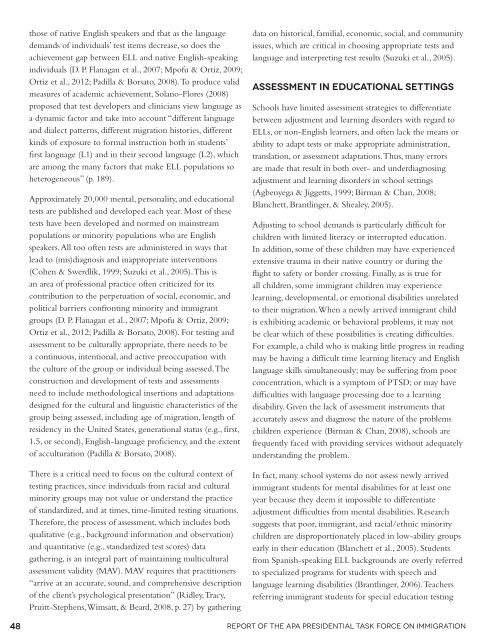Crossroads: The Psychology of Immigration in the New Century
Crossroads: The Psychology of Immigration in the New Century
Crossroads: The Psychology of Immigration in the New Century
You also want an ePaper? Increase the reach of your titles
YUMPU automatically turns print PDFs into web optimized ePapers that Google loves.
those <strong>of</strong> native English speakers and that as <strong>the</strong> language<br />
demands <strong>of</strong> <strong>in</strong>dividuals’ test items decrease, so does <strong>the</strong><br />
achievement gap between ELL and native English-speak<strong>in</strong>g<br />
<strong>in</strong>dividuals (D. P. Flanagan et al., 2007; Mp<strong>of</strong>u & Ortiz, 2009;<br />
Ortiz et al., 2012; Padilla & Borsato, 2008). To produce valid<br />
measures <strong>of</strong> academic achievement, Solano-Flores (2008)<br />
proposed that test developers and cl<strong>in</strong>icians view language as<br />
a dynamic factor and take <strong>in</strong>to account “different language<br />
and dialect patterns, different migration histories, different<br />
k<strong>in</strong>ds <strong>of</strong> exposure to formal <strong>in</strong>struction both <strong>in</strong> students’<br />
first language (L1) and <strong>in</strong> <strong>the</strong>ir second language (L2), which<br />
are among <strong>the</strong> many factors that make ELL populations so<br />
heterogeneous” (p. 189).<br />
Approximately 20,000 mental, personality, and educational<br />
tests are published and developed each year. Most <strong>of</strong> <strong>the</strong>se<br />
tests have been developed and normed on ma<strong>in</strong>stream<br />
populations or m<strong>in</strong>ority populations who are English<br />
speakers. All too <strong>of</strong>ten tests are adm<strong>in</strong>istered <strong>in</strong> ways that<br />
lead to (mis)diagnosis and <strong>in</strong>appropriate <strong>in</strong>terventions<br />
(Cohen & Swerdlik, 1999; Suzuki et al., 2005). This is<br />
an area <strong>of</strong> pr<strong>of</strong>essional practice <strong>of</strong>ten criticized for its<br />
contribution to <strong>the</strong> perpetuation <strong>of</strong> social, economic, and<br />
political barriers confront<strong>in</strong>g m<strong>in</strong>ority and immigrant<br />
groups (D. P. Flanagan et al., 2007; Mp<strong>of</strong>u & Ortiz, 2009;<br />
Ortiz et al., 2012; Padilla & Borsato, 2008). For test<strong>in</strong>g and<br />
assessment to be culturally appropriate, <strong>the</strong>re needs to be<br />
a cont<strong>in</strong>uous, <strong>in</strong>tentional, and active preoccupation with<br />
<strong>the</strong> culture <strong>of</strong> <strong>the</strong> group or <strong>in</strong>dividual be<strong>in</strong>g assessed. <strong>The</strong><br />
construction and development <strong>of</strong> tests and assessments<br />
need to <strong>in</strong>clude methodological <strong>in</strong>sertions and adaptations<br />
designed for <strong>the</strong> cultural and l<strong>in</strong>guistic characteristics <strong>of</strong> <strong>the</strong><br />
group be<strong>in</strong>g assessed, <strong>in</strong>clud<strong>in</strong>g age <strong>of</strong> migration, length <strong>of</strong><br />
residency <strong>in</strong> <strong>the</strong> United States, generational status (e.g., first,<br />
1.5, or second), English-language pr<strong>of</strong>iciency, and <strong>the</strong> extent<br />
<strong>of</strong> acculturation (Padilla & Borsato, 2008).<br />
<strong>The</strong>re is a critical need to focus on <strong>the</strong> cultural context <strong>of</strong><br />
test<strong>in</strong>g practices, s<strong>in</strong>ce <strong>in</strong>dividuals from racial and cultural<br />
m<strong>in</strong>ority groups may not value or understand <strong>the</strong> practice<br />
<strong>of</strong> standardized, and at times, time-limited test<strong>in</strong>g situations.<br />
<strong>The</strong>refore, <strong>the</strong> process <strong>of</strong> assessment, which <strong>in</strong>cludes both<br />
qualitative (e.g., background <strong>in</strong>formation and observation)<br />
and quantitative (e.g., standardized test scores) data<br />
ga<strong>the</strong>r<strong>in</strong>g, is an <strong>in</strong>tegral part <strong>of</strong> ma<strong>in</strong>ta<strong>in</strong><strong>in</strong>g multicultural<br />
assessment validity (MAV). MAV requires that practitioners<br />
“arrive at an accurate, sound, and comprehensive description<br />
<strong>of</strong> <strong>the</strong> client’s psychological presentation” (Ridley, Tracy,<br />
Pruitt-Stephens, Wimsatt, & Beard, 2008, p. 27) by ga<strong>the</strong>r<strong>in</strong>g<br />
data on historical, familial, economic, social, and community<br />
issues, which are critical <strong>in</strong> choos<strong>in</strong>g appropriate tests and<br />
language and <strong>in</strong>terpret<strong>in</strong>g test results (Suzuki et al., 2005).<br />
assessment <strong>in</strong> Educational sett<strong>in</strong>gs<br />
Schools have limited assessment strategies to differentiate<br />
between adjustment and learn<strong>in</strong>g disorders with regard to<br />
ELLs, or non-English learners, and <strong>of</strong>ten lack <strong>the</strong> means or<br />
ability to adapt tests or make appropriate adm<strong>in</strong>istration,<br />
translation, or assessment adaptations. Thus, many errors<br />
are made that result <strong>in</strong> both over- and underdiagnos<strong>in</strong>g<br />
adjustment and learn<strong>in</strong>g disorders <strong>in</strong> school sett<strong>in</strong>gs<br />
(Agbenyega & Jiggetts, 1999; Birman & Chan, 2008;<br />
Blanchett, Brantl<strong>in</strong>ger, & Shealey, 2005).<br />
Adjust<strong>in</strong>g to school demands is particularly difficult for<br />
children with limited literacy or <strong>in</strong>terrupted education.<br />
In addition, some <strong>of</strong> <strong>the</strong>se children may have experienced<br />
extensive trauma <strong>in</strong> <strong>the</strong>ir native country or dur<strong>in</strong>g <strong>the</strong><br />
flight to safety or border cross<strong>in</strong>g. F<strong>in</strong>ally, as is true for<br />
all children, some immigrant children may experience<br />
learn<strong>in</strong>g, developmental, or emotional disabilities unrelated<br />
to <strong>the</strong>ir migration. When a newly arrived immigrant child<br />
is exhibit<strong>in</strong>g academic or behavioral problems, it may not<br />
be clear which <strong>of</strong> <strong>the</strong>se possibilities is creat<strong>in</strong>g difficulties.<br />
For example, a child who is mak<strong>in</strong>g little progress <strong>in</strong> read<strong>in</strong>g<br />
may be hav<strong>in</strong>g a difficult time learn<strong>in</strong>g literacy and English<br />
language skills simultaneously; may be suffer<strong>in</strong>g from poor<br />
concentration, which is a symptom <strong>of</strong> PTSD; or may have<br />
difficulties with language process<strong>in</strong>g due to a learn<strong>in</strong>g<br />
disability. Given <strong>the</strong> lack <strong>of</strong> assessment <strong>in</strong>struments that<br />
accurately assess and diagnose <strong>the</strong> nature <strong>of</strong> <strong>the</strong> problems<br />
children experience (Birman & Chan, 2008), schools are<br />
frequently faced with provid<strong>in</strong>g services without adequately<br />
understand<strong>in</strong>g <strong>the</strong> problem.<br />
In fact, many school systems do not assess newly arrived<br />
immigrant students for mental disabilities for at least one<br />
year because <strong>the</strong>y deem it impossible to differentiate<br />
adjustment difficulties from mental disabilities. Research<br />
suggests that poor, immigrant, and racial/ethnic m<strong>in</strong>ority<br />
children are disproportionately placed <strong>in</strong> low-ability groups<br />
early <strong>in</strong> <strong>the</strong>ir education (Blanchett et al., 2005). Students<br />
from Spanish-speak<strong>in</strong>g ELL backgrounds are overly referred<br />
to specialized programs for students with speech and<br />
language learn<strong>in</strong>g disabilities (Brantl<strong>in</strong>ger, 2006). Teachers<br />
referr<strong>in</strong>g immigrant students for special education test<strong>in</strong>g<br />
48 Report <strong>of</strong> <strong>the</strong> APA Presidential Task Force on <strong>Immigration</strong>
















